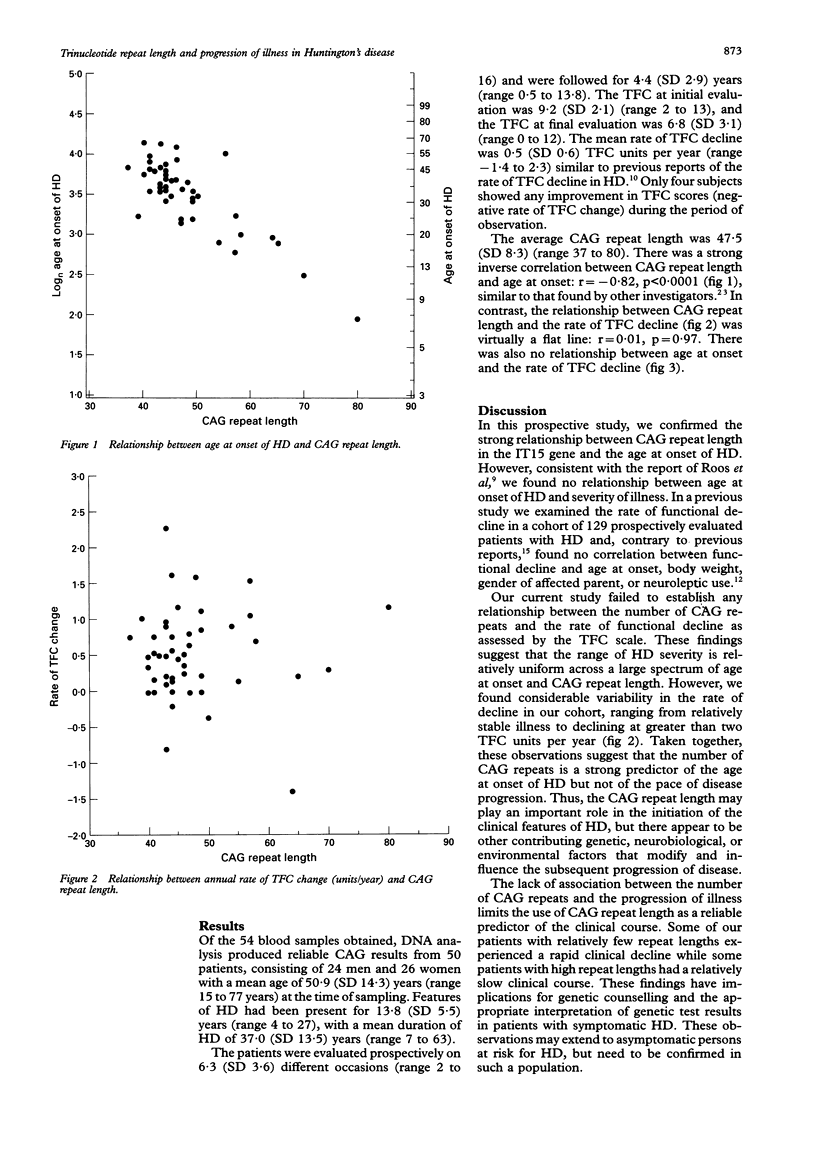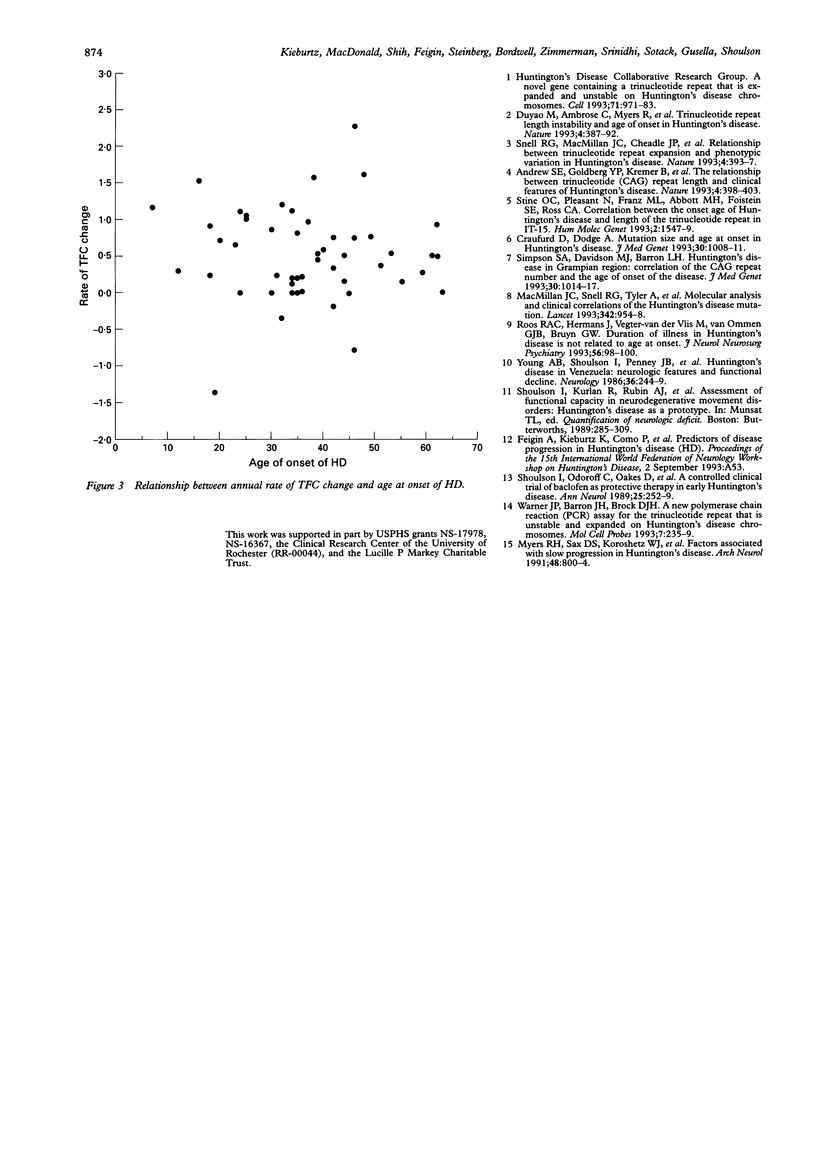Abstract
The genetic defect causing Huntington's disease (HD) has been identified as an unstable expansion of a trinucleotide (CAG) repeat sequence within the coding region of the IT15 gene on chromosome 4. In 50 patients with manifest HD who were evaluated prospectively and uniformly, we examined the relationship between the extent of the DNA expansion and the rate of illness progression. Although the length of CAG repeats showed a strong inverse correlation with the age at onset of HD, there was no such relationship between the number of CAG repeats and the rate of clinical decline. These findings suggest that the CAG repeat length may influence or trigger the onset of HD, but other genetic, neurobiological, or environmental factors contribute to the progression of illness and the underlying pace of neuronal degeneration.
Full text
PDF


Selected References
These references are in PubMed. This may not be the complete list of references from this article.
- Andrew S. E., Goldberg Y. P., Kremer B., Telenius H., Theilmann J., Adam S., Starr E., Squitieri F., Lin B., Kalchman M. A. The relationship between trinucleotide (CAG) repeat length and clinical features of Huntington's disease. Nat Genet. 1993 Aug;4(4):398–403. doi: 10.1038/ng0893-398. [DOI] [PubMed] [Google Scholar]
- Craufurd D., Dodge A. Mutation size and age at onset in Huntington's disease. J Med Genet. 1993 Dec;30(12):1008–1011. doi: 10.1136/jmg.30.12.1008. [DOI] [PMC free article] [PubMed] [Google Scholar]
- Duyao M., Ambrose C., Myers R., Novelletto A., Persichetti F., Frontali M., Folstein S., Ross C., Franz M., Abbott M. Trinucleotide repeat length instability and age of onset in Huntington's disease. Nat Genet. 1993 Aug;4(4):387–392. doi: 10.1038/ng0893-387. [DOI] [PubMed] [Google Scholar]
- MacMillan J. C., Snell R. G., Tyler A., Houlihan G. D., Fenton I., Cheadle J. P., Lazarou L. P., Shaw D. J., Harper P. S. Molecular analysis and clinical correlations of the Huntington's disease mutation. Lancet. 1993 Oct 16;342(8877):954–958. doi: 10.1016/0140-6736(93)92002-b. [DOI] [PubMed] [Google Scholar]
- Roos R. A., Hermans J., Vegter-van der Vlis M., van Ommen G. J., Bruyn G. W. Duration of illness in Huntington's disease is not related to age at onset. J Neurol Neurosurg Psychiatry. 1993 Jan;56(1):98–100. doi: 10.1136/jnnp.56.1.98. [DOI] [PMC free article] [PubMed] [Google Scholar]
- Shoulson I., Odoroff C., Oakes D., Behr J., Goldblatt D., Caine E., Kennedy J., Miller C., Bamford K., Rubin A. A controlled clinical trial of baclofen as protective therapy in early Huntington's disease. Ann Neurol. 1989 Mar;25(3):252–259. doi: 10.1002/ana.410250308. [DOI] [PubMed] [Google Scholar]
- Simpson S. A., Davidson M. J., Barron L. H. Huntington's disease in Grampian region: correlation of the CAG repeat number and the age of onset of the disease. J Med Genet. 1993 Dec;30(12):1014–1017. doi: 10.1136/jmg.30.12.1014. [DOI] [PMC free article] [PubMed] [Google Scholar]
- Snell R. G., MacMillan J. C., Cheadle J. P., Fenton I., Lazarou L. P., Davies P., MacDonald M. E., Gusella J. F., Harper P. S., Shaw D. J. Relationship between trinucleotide repeat expansion and phenotypic variation in Huntington's disease. Nat Genet. 1993 Aug;4(4):393–397. doi: 10.1038/ng0893-393. [DOI] [PubMed] [Google Scholar]
- Stine O. C., Pleasant N., Franz M. L., Abbott M. H., Folstein S. E., Ross C. A. Correlation between the onset age of Huntington's disease and length of the trinucleotide repeat in IT-15. Hum Mol Genet. 1993 Oct;2(10):1547–1549. doi: 10.1093/hmg/2.10.1547. [DOI] [PubMed] [Google Scholar]
- Warner J. P., Barron L. H., Brock D. J. A new polymerase chain reaction (PCR) assay for the trinucleotide repeat that is unstable and expanded on Huntington's disease chromosomes. Mol Cell Probes. 1993 Jun;7(3):235–239. doi: 10.1006/mcpr.1993.1034. [DOI] [PubMed] [Google Scholar]
- Young A. B., Shoulson I., Penney J. B., Starosta-Rubinstein S., Gomez F., Travers H., Ramos-Arroyo M. A., Snodgrass S. R., Bonilla E., Moreno H. Huntington's disease in Venezuela: neurologic features and functional decline. Neurology. 1986 Feb;36(2):244–249. doi: 10.1212/wnl.36.2.244. [DOI] [PubMed] [Google Scholar]


